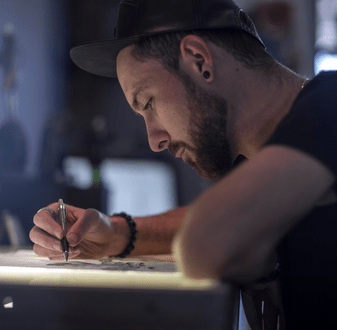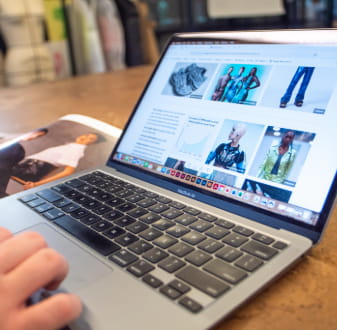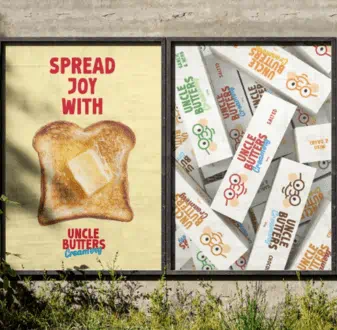The most important aspect of becoming an exceptional graphic designer is to begin with the end in mind.
The best way to think about the creative process is to see it as anything that happens before a creative result (whether that be a billboard, packaging solutions, animations or NFTs). It doesn’t just happen – there is a specific trajectory of steps taken to get to the end result.
Shaping the way we think and behave, Graphic Design is a powerful tool for corporations, governments, activists and individuals. The current trend in graphic design is not only about making beautiful work, it’s about designing to create a meaningful and positive impact. In other words, “Design for Good”.
There is always something new to learn, fresh challenges to face and exciting innovations to bring into your own projects. So where should you start?
Want to study graphic design?
The skills you learn while undertaking a Diploma of Graphic Design will stand you in good stead throughout your time in the industry, and the contacts you make at university are one of the greatest assets – both in terms of finding work and developing your craft.
Graphic design requirements are varied, depending on the specific path you want to follow, but there are generalist skills that are important to master no matter which direction you’re headed in.

What skills and basics should a graphic designer know
At its core, this discipline is about communication, which means your role is to translate a message or an idea into a visual form. At a basic level, this can be as simple as selecting a font that is readable or putting information into easily digestible chunks. But the deeper you go, the more you will come to understand how different audiences connect and respond to your work, and the best ways to shape your design to suit their needs.
Design thinking
This is an iterative and non-linear process where designers work through phases to understand and synthesise user needs, to ideate, prototype and test a design solution. Not limited to graphic design, this process is used every day by start-ups, big enterprises and professionals around the world. Mastering the skill of design thinking can help you uncover original and innovative solutions and will stand you apart in the design world.
Idea generation
Generating ideas is exciting, confronting, confounding and extraordinarily satisfying. It will keep you up at night, stop you mid-sentence and send you off in directions you never expected. From the initial seed of an idea, through to the ‘a-ha’ or ‘eureka’ moment, you are on a creative rollercoaster, making your way through essential processes, practices and stages until you reach the end result.
Ideation is a process of synthesis. Like a funnel, it’s wide at one end to admit everything you can think of. Then, as you move through the process, that funnel narrows down int focus to ensure that your final result is innovative and creative while also corresponding to the initial brief.
Ideas can revolutionise industries and societies, and as a designer, ideas can revolutionise your career. Learning how to generate ideas is critical to any design genre.
Design principles
The basis of all design is the arrangement of the elements of a work of art, using specific design principles. It is the bringing together of various components into one area and arranging them in such a way as to create a composition, layout or design that is both unified and pleasing to look at.
Below are some design principles you will need an understanding of as a graphic designer:
- Typography – How to use fonts to best effect, in terms of impact, legibility and more
- Hierarchy – How to showcase information in order of importance, for optimum efficiency in getting your message across
- Alignment – Building your design with knowledge of how people read, and how their eye tends to move across a page, screen or label
- Consistency – Working within a theme, whether that entails a limited colour scheme or selection of fonts, or within pre-established brand guidelines
- Contrast – Using opposing elements, such as size, colour and texture, to create an impact.
This awareness will assist you as you begin to develop your own design aesthetic. That’s why it’s most useful to learn your craft in an environment facilitated by industry-connected experts and populated with eager, collaboration-minded creatives who will support and guide you.
If you’re already across the fundamental design skills and are looking for more advanced learnings, our Bachelor of Communication Design covers typographic systems, brand strategy, customer experience and service design.
Brief etiquette and client management
Becoming familiar with the briefing process: how to unpack a brief, present concepts to clients, respond to feedback, and guide them in terms of timelines and budgets, is a critical part of the role and something that you’ll gain in a diploma or bachelor-level qualification.
Billy Blue College of Design courses helps you to develop these practical skills by working on actual industry briefs. The commercial skills and the experience you gain will support you throughout your career – whether that is setting up your own agency or levelling up into that creative director role.
“A special project I recently did was the rebranding and marketing for Infinity, which is a high-rise building in Broadbeach,” explains Bachelor of Communication Design student Martina Zatta. “I really felt confident in doing this with the knowledge and experience that I had gained from my first year studying at Billy Blue.”
What tools and programs should a graphic designer know?
Working as a graphic designer means knowing how to use the software tools that are standard across the industry. This will absolutely mean knowing your way around the Adobe suite of programs, which includes apps you may have heard of, such as PhotoShop, Illustrator and InDesign.
These may be daunting when you first encounter them but watch an experienced designer pull together a magazine layout and it can seem like magic. They are powerful, flexible tools that will help you bring your vision to life – whether that’s an inspirational mood board for an upcoming digital campaign, packaging for a range of beauty products or a set of data-driven infographics.
When you study at Billy Blue College of Design, you’ll receive a free Adobe Creative Cloud Pro licence for the entire duration of your course, as well as have access to small class workshops so you’ll have plenty of time to play with all the tools in the suite. This is really important because it gives you the chance to experiment and ask questions of your expert lecturers, becoming comfortable with the software that you will use every day in your future work.
Once you’ve mastered the likes of Adobe, you’ll have the core principles to apply to new and emerging design software.
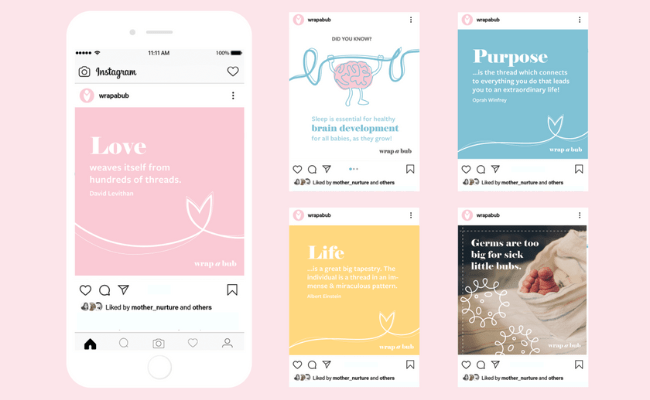
How to become a graphic designer
Building a portfolio is an important step along the journey to a rewarding career in graphic design. Some of this you will do through working on your own projects and experiments, and some of it will come from those industry briefs and other assignments you undertake as part of your study with us.
A portfolio can be tailored to different roles and organisations, but should always showcase your particular areas of expertise, the kind of work you’re passionate about and the skills you’re developing.
Alongside these generalist skills, Billy Blue College of Design’s Diploma of Graphic Design has specialised packaging and branding design subjects, and a range of electives to select from including Illustration, Camera and Capture and Data Visualisation. And as part of the course, you’ll also develop base skills in typography, concept development, asset creation, 2D animation, and user experience (UX) and interaction design for the web.
Nothing stands still in this space – flip through an old magazine or check out the development of Pepsi’s logo to see how different the design choices were in the past. This is a career where you’ll constantly be learning new tricks, paying attention to evolving graphic design trends and dealing with constant change.
That’s also true of the kinds of work you’ll be doing. Listen to Imogen Frost, one of our award-winning graduates. “One day I might be working on creating a website or another day I might be running a photoshoot,” she says, “or I might be checking print proofs or packaging that I’ve just designed.”
Professional relationships are one of the strongest ways to forge a career, as well as opportunities to extend your skills by swapping tips and insights. Some of this relationship-building will happen organically, especially when you’re collaborating with fellow students and liaising with our industry partners, but it’s also useful to leverage the ability to join the Design Institute of Australia (who help guarantee we only offer recognised graphic design courses).
Our students excel in competitions like the AGDA Design Awards, gaining recognition in the broader industry even before they graduate. “Industry recognition means everything,” explains our Academic Director, Industry, Nathan Scoular. “It’s a powerful validator for what we do, shining a spotlight on the capacity of our students and the relevance of our curriculum.” Check out some of our 2022 success stories.
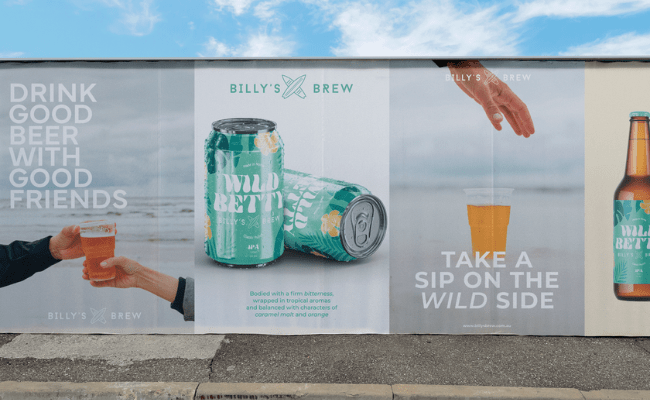
Graphic design career paths
Graphic design is the launchpad to a wide range of careers, each with its own exciting challenges and rewards. Digital specialties are emerging, with attendant skills that are transferable across many industries and sectors – including marketing, digital and print media, fashion, product development and more.
More specifically, studying graphic design courses can lead to employment in roles such as:
- Art director – Leading a team by example, setting the style, tone and voice for each project;
- Publishing designer – Collaborating with other creatives to present content in an engaging, easily digestible style
- Brand designer – creating and reworking brand stories, and creating elements such as logos, trade dress and physical environments to maximise the impact
- UX and UI designer – Crafting experiences, products and interfaces that are engaging and useful
- Web designer – Building the future of online interactions, shaping the layout of websites and apps
- Motion designer – Developing motion graphics for major film titles, television, video games and advanced branded assets
- Creative director – Spearheading the overall design aspects of a project, leading a team (or teams) to ensure the finished product matches the initial vision
- Studio owner – Leads the daily operations of a creative studio
A Diploma of Graphic Design provides a broad base of general and specialist knowledge, with a focus on design awareness, problem-solving and technical skills. It builds a foundation in graphic design, combining theory with hands-on experience. Under guidance from industry professionals, you’ll develop a portfolio to showcase your skills and graduate prepared for the diverse needs of a fast-paced, visually literate society.
“Everything starts with design. It touches every aspect of our lives,” says Peita Jackson, who pivoted from real estate to complete a Diploma of Graphic Design at Torrens University Australia. “Every one of us will make an impact on the future of design. If everything starts with design, let’s start with design for good.”

